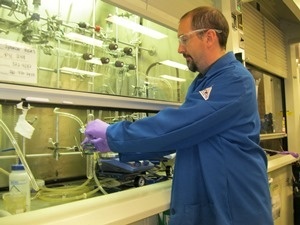Sometimes the barrier to a healthy safety culture may not be in the lab but in your assumptions.
Prof. Monte Helm had some trepidation about doing research at Pacific Northwest National Laboratory (PNNL). He feared a “government-run laboratory with inflexible rules instituted by someone with no experience working with dangerous compounds,” he says. But Helm, a chemistry professor at Fort Lewis College in Durango, Colorado, had an entirely different experience at PNNL. And he brought that inspiration back to enhance his own laboratory.
“It was the opposite of what I expected. PNNL's implementation of safety rules helped our research move forward in a safe and effective way. My experiences at PNNL led me to consider how I could implement similar safety rules and procedures at my Fort Lewis lab." Helm had suspected that his students did not follow rigorous safety procedures. After his national lab experience, he determined to change that.
Helm presented his observations recently to postdocs at PNNL, which published his findings in a Lessons Learned. Among the changes he says he brought back to his research group:
- The determination to improve their safety culture. When in the lab, students are now required to:
- Use PPE: eye protection, lab coats, gloves
- Work in fume hoods with the sashes set correctly
- Follow standard lab rules.
- Remind others if they are not following safety rules.
Helm, now a senior scientist and deputy director of the Center for Molecular Electrocatalysis at PNNL’s Physical Sciences Laboratory, cites other lessons learned from his national laboratory experience:
- Top-down. In any lab, safety culture starts with the principal investigator, who must:
- Remove obstacles to safe practices by making safety equipment readily available.
- Inculcate the importance of safety culture into lab workers’ — and students’ — behavior. At his college lab, Helm says, “only about 10%” of postdocs arrive with proper safety culture awareness.
- Supervise. Helm’s PNNL EHS representative shadowed him. “She was invested in keeping the lab safe, not inhibiting my progress. It’s important to know somebody is watching out for you.”
- Responsibility. Safety violations can have great impact and affect a wide range of people. At a university, researchers may feel they have more freedom to experiment without restrictive safety rules, Helm says. But in his national lab experience, safety rules enabled successful research by reducing risks.
- National lab groups work together closely, watching out for one another.
- Safety culture creates pride in one’s work.
- Safety promotes good science.
- A strong safety culture protects the institution’s reputation.
- Meetings. Safety meetings reinforce protocols.
- At PNNL, Helm’s group met monthly to discuss safety and recent incidents. At the university, however, “we didn’t sit down and talk about safety or discuss why it’s important.”
- When accidents happen, they are discussed in meetings. The broader worry at the national lab is, “How can we minimize risk to researchers and create a reputation for doing work safely?”
Note: From PNNL Lessons Learned
